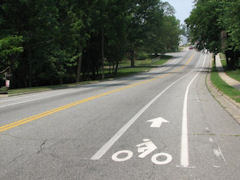Having given wall-to-wall coverage of the bicycling fatality of Lanie Kruszewski (see “Richmond’s First Bicycle Martyr“), the Richmond Times-Dispatch has ratcheted up to top gear on its coverage of bicycle issues. Publisher Thomas Silvestri has been plugging bicycle-friendly policies in the weekend op-ed pages for some time, and now even the newsroom is treating it as a serious issue.
It’s about time, considering that 2.2% of all commuting trips — purportedly the highest percentage in the state — occur on bicycles, often under hostile riding conditions. The most visible project is the Virginia Capital Trail running along the James River and linking Richmond with Williamsburg. While that undoubtedly will become a great recreational resource, it won’t alter the transportation picture. The real change will come from making streets and roads hospitable to utility travel — people using bikes instead of cars to ride to work or run errands.
We are seeing the opening salvos in what will become a long-running conflict to redefine the rights of bikers on streets and roads. There will be two main fronts: cultural and infrastructure. As the Kruszewski tragedy made painfully clear, bikes and vehicle drivers have to get accustomed to sharing the road.
Local governments also need to build a network of safe bike trails and bike lanes. The real action is taking place in the City of Richmond. The city, which created a commission to study cycling mobility, is expanding shared-lane markings on city streets following pilot implementations on Meadow, Harrison and Leigh streets. One route would run north-south along U.S. Bike Route 1, while an east-west route would run from the University of Richmond through the Fan, skirting downtown and ending at the Henrico County line on the east.
According to the T-D article, other regional initiatives include:
- Chesterfield County is looking at connecting county parks with a bicycle and pedestrian trail, and they are planning to add bicycle lanes to some roads when they are widened are improved.
- Henrico County, once described as the most bicycle-hostile county in the United States, is adding a lane for bicycles and pedestrians to parts of the North Gayton Road extension.
- The University of Richmond is considering making a 1,500-foot abandoned road more accessible to bicycles.
It’s great to see bits and pieces of bicycle infrastructure emerge. But we won’t reach critical mass until the pieces connect, creating a network of bicycle-friendly lanes and paths that where people can travel safely without fear of becoming the next Lanie Kruszewski. It will be the task of a generation to create that network. If you’d asked me a year ago, I would have called it a fool’s errand. But the movement seems to be gaining serious momentum.
— JAB



